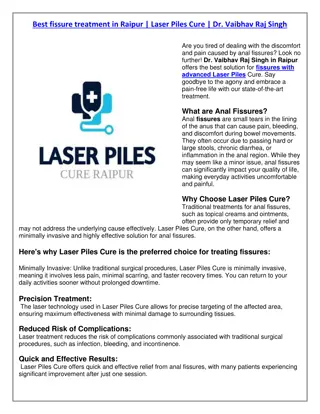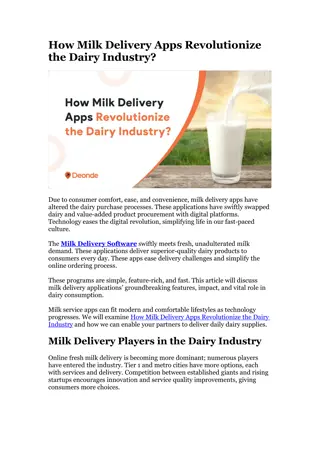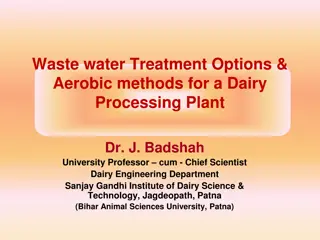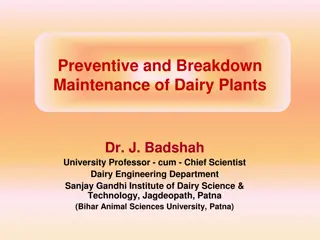Understanding Stabilizers in Dairy Technology by B.K. Singh
Stabilizers are key ingredients used in ice cream and related products to enhance viscosity, stability, texture, and shelf life. They help in preventing wheying off, controlling crystal growth, and maintaining product quality during storage. Various types of stabilizers, including proteins, plant exudates, seed gums, microbial gums, seaweed extracts, pectins, and cellulose derivatives, play crucial roles in food applications. Properties of individual stabilizers like Sodium Alginate and Carrageenan are highlighted for their functionality in creating stable gels. Locust Bean Gum and Guar Gum are also discussed as essential stabilizers in food formulations.
Uploaded on Jul 16, 2024 | 0 Views
Download Presentation

Please find below an Image/Link to download the presentation.
The content on the website is provided AS IS for your information and personal use only. It may not be sold, licensed, or shared on other websites without obtaining consent from the author. Download presentation by click this link. If you encounter any issues during the download, it is possible that the publisher has removed the file from their server.
E N D
Presentation Transcript
STABILIZERS Dairy Technology B.K.Singh,Dairy Technology 1
Stabilizers are a group of water-soluble or water- dispersible biopolymers used in small amounts (typically 0.2%) in ice cream, sorbets, water ices and other foods. 2
Role of Stabilizers in Ice Cream To increase the viscosity of the mix. To stabilize the mix i.e. to prevent wheying off To help in suspension of flavouring particles. To produce a stable foam with desired stiffness at the time of packaging To reduce or slow down the growth of lactose crystals during storage mainly during temperature fluctuations. To reduce moisture migration from the product to the package or the air To help prevent shrinkage of the product volume during storage. To provide uniformity to the product and resistance to melting. To produce smoothness in texture during consumption. Reduce the rate of meltdown (i.e. the rate at which ice cream melts). Prevent shrinkage and slow down moisture migration out of ice. Mask the detection of ice crystals in the mouth during eating. Allow easier pumping and more accurate filling during processing. Facilitate the controlled in corporation of air in the freezer. 3
Classification of stabilizers Proteins- Gelatin Plantexudates Arabic, ghatti, karaya and tragacanth gums Seed gums Locust ( carob) bean, guar, psyllium, starch and modified starches Microbialgums Xanthan Seaweed extracts agar, alginates, carageena Pectins low and high methoxyl Cellulose sodium carboxymethyl cellulose, microcrystalline cellulose, methyl and methylethyl cellulose, hydroxypropyl and hydroxypropylmethyl cellulose. 4
Properties of individual stabilizer ingredients Sodium Alginate Alginates are produced from the processing of brown brown seaweed seaweed, typically Macrocystis pyrefera. The algin found in kelp is present as a mixed salt (sodium and/or potassium, calcium, magnesium) with alginic acid. Through processing, the insoluble alginic alginic acid acid is extracted and various water-soluble alginates can produced. The most commercially utilized of the alginates is Sodium Alginate. Its ability to react with a divalent or trivalent metal ion (most commonly Calcium) to create a chemically set, irreversible gel has proved to be useful in many food applications. Alginates water- be 5
Guar Gum 8
Pectin Pectin can be used as a thickener, stabilizer, emulsifier. It is a white, light yellow, light gray or light brown powder, smell, insoluble in ethanol and other organic solvents. The methoxyl is higher than 7%, it is called high methoxyl pectin, or it is low- methoxyl pectin. The higher methoxyl content, the stronger the gel. Only when the sugar content is greater than the 60%,PH 2.6--3.4, high methoxyl pectin has the ability to gel; as long as there is a polyvalent metal ions, such as calcium, magnesium and aluminum methoxyl pectin can form gels. Typical levels of pectin in fresh fruits vegetables are: Apples, 1 1.5% Apricots, 1% Cherries, 0.4% Oranges, 0.5 3.5% Carrots 1.4% Citrus peels, 30% Rose hips, 15% slightly specific plasma, low- 9
Xanthan gum 10
Gelatin 12























